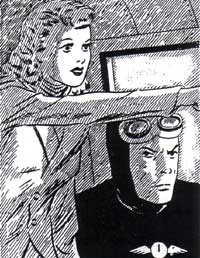|

This story was published in Radio Recall, the journal of the Metropolitan Washington Old-Time Radio Club, published six times per year.
Click here to return to the index of selected articles.
|
|
CAPTAIN MIDNIGHT'S UNIFORM
by Stephen A. Kallis, Jr.
(From Radio Recall, August 2003)
As any Captain Midnight fan is aware, there were several Captain Midnight variants from the original radio program. Besides the broadcast, there was a movie serial, a newspaper comic strip, a long-running comic book, and a television show. Since all derived from the original radio show, that radio program has to be considered the "mother lode" of the legend.
| The comic book published by Fawcett had the most often seen "uniform" of Captain Midnight. It’s a superhero’s skintight "long underwear" garment, with an aviator’s helmet and goggles. It had a huge winged-clock symbol emblazoned on the hero’s chest. It was rather eye-catching, as were most comic-book hero costumes.
The 1942 Columbia movie serial had Captain Midnight as a Secret Identity. But not counting the mask, the basic "uniform" was a leather jacket with a small winged-clock symbol where standard pilot wings would be on a uniform shirt, pilot helmet, and jodhpur-style trousers. |
 |
| "Captain Midnight!" Joyce exclaimed, "Look!" |
The television show had a jumpsuit and helmet as flying togs. The "office" uniform was not dissimilar to the uniform of an officer in an armed service.
The most striking uniform was illustrated in the Whitman "Book for Girls" hardcover book, Joyce of the Secret Squadron, by R. R. Winterbotham, based on the radio scripts involving the hunt for a stolen Flying Wing early in World War II. The illustration shows Captain Midnight in an all-black uniform: black upper body wear, black jodhpur-style trousers, black boots, and a black helmet with coordinated goggles. To be sure, the winged-clock symbol was on the upper garment in the pilot-wing position.
But what of the "real" Captain Midnight? The only pictures of him were primarily in the manuals that accompanied the Code-O-Graph cipher premiums issued periodically by the sponsor, Ovaltine. Unfortunately, these are basically pictures of his head, wearing a flying helmet. The description of the uniform was never detailed, but could be inferred from the stories.
One of the first major Secret Squadron stories of World War II was the quest for a Flying Wing prototype that had been stolen by an agent of the Barracuda, who worked for various Japanese clients. At the beginning of the story, we find a Secret Squadron installation established on a previously uninhabited island in the Pacific Ocean, vaguely described as being "south of Hawaii and north of Palmyra."
On the base, all Secret Squadron personnel were in uniform, and Captain Midnight was there, supervising its operations. While there, the Secret Squadron leader got his instructions by a mysterious personage from the U.S. Government, and before he could undertake the mission , met another visitor. This personage was a notorious lady spy, Carla Rotan, in disguise, as a "Mrs. Bosmouth." The spy, who surveyed the whole establishment, was unsure whether the leader of the base was Captain Midnight or a conventional military officer until Chuck Ramsay unwittingly identified him.
Later during the war, the Secret Squadron had a base in England. Because they had no special identification on their uniforms, Chuck Ramsay was detained by British military police until the liaison officer from British Intelligence was able to vouch for him. Both of these separate incidents indicate that the Secret Squadron uniform was highly similar to the uniforms of other U.S. armed forces, and that Captain Midnight’s uniform was identical to that of other Squadron members.
The incident in the U.K. led to issuing a distinctive winged-clock patch to identify Secret Squadron personnel to Allied armed forces personnel; but as a paramilitary force, no Secret Squadron agents had any indication of rank. For work in occupied France, the Secret Squadron came up with a new uniform -- a Navy-blue shirt and slacks, black shoes, and a black scarf (and black Squadron wings for pilots) -- which was still like the uniforms of the more conventional service personnel. There was no difference between the uniform Captain Midnight wore and that of the other Secret Squadron members.
After the war, Secret Squadron members generally wore civilian clothes except when acting as part of a flight crew or for missions where a uniform would be more appropriate. The Secret Squadron avoided the garish and spectacular throughout its operations.
|